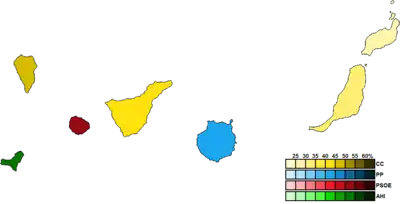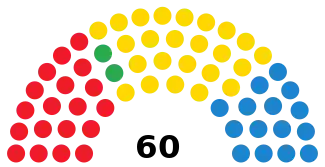1999 Canarian regional election
The 1999 Canarian regional election was held on Sunday, 13 June 1999, to elect the 5th Parliament of the Autonomous Community of the Canary Islands. All 60 seats in the Parliament were up for election. The election was held simultaneously with regional elections in twelve other autonomous communities and local elections all throughout Spain, as well as the 1999 European Parliament election.
| ||||||||||||||||||||||||||||||||||||||||||||||||||||||||||||||||||||||||||||||||||
All 60 seats in the Parliament of the Canary Islands 31 seats needed for a majority | ||||||||||||||||||||||||||||||||||||||||||||||||||||||||||||||||||||||||||||||||||
|---|---|---|---|---|---|---|---|---|---|---|---|---|---|---|---|---|---|---|---|---|---|---|---|---|---|---|---|---|---|---|---|---|---|---|---|---|---|---|---|---|---|---|---|---|---|---|---|---|---|---|---|---|---|---|---|---|---|---|---|---|---|---|---|---|---|---|---|---|---|---|---|---|---|---|---|---|---|---|---|---|---|---|
| Opinion polls | ||||||||||||||||||||||||||||||||||||||||||||||||||||||||||||||||||||||||||||||||||
| Registered | 1,331,110 | |||||||||||||||||||||||||||||||||||||||||||||||||||||||||||||||||||||||||||||||||
| Turnout | 835,181 (62.7%) | |||||||||||||||||||||||||||||||||||||||||||||||||||||||||||||||||||||||||||||||||
| ||||||||||||||||||||||||||||||||||||||||||||||||||||||||||||||||||||||||||||||||||
 Constituency results map for the Parliament of the Canary Islands | ||||||||||||||||||||||||||||||||||||||||||||||||||||||||||||||||||||||||||||||||||
| ||||||||||||||||||||||||||||||||||||||||||||||||||||||||||||||||||||||||||||||||||
Overview
Electoral system
The Parliament of the Canary Islands was the devolved, unicameral legislature of the autonomous community of the Canary Islands, having legislative power in regional matters as defined by the Spanish Constitution and the Canarian Statute of Autonomy, as well as the ability to vote confidence in or withdraw it from a President of the Government.[1] Voting for the Parliament was on the basis of universal suffrage, which comprised all nationals over 18 years of age, registered in the Canary Islands and in full enjoyment of all political rights, entitled to vote.
The 60 members of the Parliament of the Canary Islands were elected using the D'Hondt method and a closed list proportional representation, with an electoral threshold of 30 percent of valid votes—which included blank ballots—being applied in each constituency. Alternatively, parties could also enter the seat distribution as long as they reached six percent regionally. Seats were allocated to constituencies, corresponding to the islands of El Hierro, Fuerteventura, Gran Canaria, La Gomera, La Palma, Lanzarote and Tenerife. Each constituency was allocated a fixed number of seats: 3 for El Hierro, 7 for Fuerteventura, 15 for Gran Canaria, 4 for La Gomera, 8 for La Palma, 8 for Lanzarote and 15 for Tenerife.[1]
The electoral law provided that parties, federations, coalitions and groupings of electors were allowed to present lists of candidates. However, groupings of electors were required to secure the signature of at least 1 percent of the electors registered in the constituency for which they sought election. Electors were barred from signing for more than one list of candidates. Concurrently, parties and federations intending to enter in coalition to take part jointly at an election were required to inform the relevant Electoral Commission within ten days of the election being called.[2][3][4]
Election date
The term of the Parliament of the Canary Islands expired four years after the date of its previous election. Elections to the Parliament were fixed for the fourth Sunday of May every four years. Legal amendments introduced in 1998 allowed for these to be held together with European Parliament elections, provided that they were scheduled for within a four month-timespan. The previous election was held on 28 May 1995, setting the election date for the Parliament concurrently with a European Parliament election on Sunday, 13 June 1999.[1][2][3][4]
The Parliament of the Canary Islands could not be dissolved before the date of expiry of parliament except in the event of an investiture process failing to elect a regional President within a two-month period from the first ballot. In such a case, the Parliament was to be automatically dissolved and a snap election called, with elected deputies merely serving out what remained of their four-year terms.[1]
Opinion polls
The table below lists voting intention estimates in reverse chronological order, showing the most recent first and using the dates when the survey fieldwork was done, as opposed to the date of publication. Where the fieldwork dates are unknown, the date of publication is given instead. The highest percentage figure in each polling survey is displayed with its background shaded in the leading party's colour. If a tie ensues, this is applied to the figures with the highest percentages. The "Lead" column on the right shows the percentage-point difference between the parties with the highest percentages in a poll. When available, seat projections determined by the polling organisations are displayed below (or in place of) the percentages in a smaller font; 31 seats were required for an absolute majority in the Parliament of the Canary Islands.
| Polling firm/Commissioner | Fieldwork date | Sample size | Turnout | FNC | Lead | |||||
|---|---|---|---|---|---|---|---|---|---|---|
| 1999 regional election | 13 Jun 1999 | — | 62.7 | 36.9 24 |
27.1 15 |
24.0 19 |
2.7 0 |
4.8 0 |
0.3 2 |
9.8 |
| Eco Consulting/ABC[p 1] | 24 May–2 Jun 1999 | ? | ? | 37.1 22/23 |
31.0 17/19 |
20.1 15/17 |
– | 3.3 3/4 |
0.3 1/2 |
6.1 |
| Demoscopia/El País[p 2] | 26 May–1 Jun 1999 | ? | 63 | 35.2 21 |
33.7 19/20 |
22.3 16/17 |
4.7 0 |
1.0 2 |
0.3 1 |
1.5 |
| CIS[p 3][p 4][p 5] | 3–23 May 1999 | 1,599 | 64.0 | 36.5 23/24 |
32.1 18/19 |
21.1 14/15 |
3.6 0 |
4.3 2/3 |
0.3 1/2 |
4.4 |
| Sigma Dos/El Mundo[p 6][p 7] | 17–20 May 1999 | 1,000 | ? | 31.9 19/22 |
31.6 19/21 |
23.4 17/19 |
5.3 0 |
3.3 0/2 |
? 0/1 |
0.3 |
| 1996 general election | 3 Mar 1996 | — | 69.1 | 25.1 | 37.6 | 30.0 | 5.5 | – | [lower-alpha 2] | 7.6 |
| 1995 regional election | 28 May 1995 | — | 64.2 | 32.8 21 |
31.1 18 |
23.1 16 |
5.1 0 |
3.0[lower-alpha 3] 4 |
0.3 1 |
1.7 |
Results
Overall
 | ||||||
| Parties and alliances | Popular vote | Seats | ||||
|---|---|---|---|---|---|---|
| Votes | % | ±pp | Total | +/− | ||
| Canarian Coalition (CC) | 306,658 | 36.93 | +4.13 | 24 | +3 | |
| People's Party (PP) | 225,316 | 27.13 | –3.94 | 15 | –3 | |
| Spanish Socialist Workers' Party (PSOE) | 199,503 | 24.03 | +0.95 | 19 | +3 | |
| Canarian Nationalist Federation (FNC)1 | 39,947 | 4.81 | +1.81 | 0 | –4 | |
| Canarian United Left (IUC) | 22,768 | 2.74 | –2.36 | 0 | ±0 | |
| The Greens of the Canaries (Verdes) | 12,146 | 1.46 | New | 0 | ±0 | |
| Centrist Union–Democratic and Social Centre (UC–CDS) | 4,442 | 0.53 | –0.14 | 0 | ±0 | |
| Independent Herrenian Group (AHI) | 2,773 | 0.33 | +0.07 | 2 | +1 | |
| Humanist Party (PH) | 1,346 | 0.16 | –0.04 | 0 | ±0 | |
| Nationalist Maga Alternative (AMAGA) | 864 | 0.10 | New | 0 | ±0 | |
| Canarian Alternative–Independent Citizens of the Canaries (AC–CICA) | 806 | 0.10 | New | 0 | ±0 | |
| Pensionist Assembly of the Canaries (TPC) | 692 | 0.08 | New | 0 | ±0 | |
| Fuerteventura Popular Platform (PPF) | 533 | 0.06 | New | 0 | ±0 | |
| Blank ballots | 12,558 | 1.51 | +0.37 | |||
| Total | 830,352 | 60 | ±0 | |||
| Valid votes | 830,352 | 99.42 | –0.01 | |||
| Invalid votes | 4,829 | 0.58 | +0.01 | |||
| Votes cast / turnout | 835,181 | 62.74 | –1.46 | |||
| Abstentions | 495,929 | 37.26 | +1.46 | |||
| Registered voters | 1,331,110 | |||||
| Sources[5][6][7] | ||||||
Footnotes:
| ||||||
Distribution by constituency
| Constituency | CC | PP | PSOE | AHI | ||||
|---|---|---|---|---|---|---|---|---|
| % | S | % | S | % | S | % | S | |
| El Hierro | 22.8 | − | 23.1 | 1 | 51.3 | 2 | ||
| Fuerteventura | 34.7 | 3 | 21.1 | 2 | 26.7 | 2 | ||
| Gran Canaria | 31.8 | 5 | 40.3 | 7 | 18.4 | 3 | ||
| La Gomera | 31.2 | 1 | 10.9 | − | 50.3 | 3 | ||
| La Palma | 47.3 | 4 | 21.3 | 2 | 27.0 | 2 | ||
| Lanzarote | 28.5 | 4 | 13.3 | 1 | 24.2 | 3 | ||
| Tenerife | 43.0 | 7 | 16.2 | 3 | 28.6 | 5 | ||
| Total | 36.9 | 24 | 27.1 | 15 | 24.0 | 19 | 0.3 | 1 |
Notes
- Results for PCN in the 1995 election.
- Within CC.
- Result for Nationalist Canarian Platform.
References
- Opinion poll sources
- "Canarias Coalición Canaria signe primera y sube". ABC (in Spanish). 7 June 1999.
- "Coalición Canaria sigue siendo la fuerza más votada". El País (in Spanish). 7 June 1999.
- "Preelectoral elecciones autonómicas y municipales, 1999. Comunidad Autónoma de Canarias (Estudio nº 2329. Mayo 1999)". CIS (in Spanish). 4 June 1999.
- "Estudio CIS nº 2329. Ficha técnica" (PDF). CIS (in Spanish). 4 June 1999.
- "Bono e Ibarra repiten y el PSOE recuperará Asturias". La Vanguardia (in Spanish). 5 June 1999.
- "Canarias: la incógnita de las alianzas". El Mundo (in Spanish). 24 May 1999.
- "ELECCIONES 13-J/BALANCE DE LAS ENCUESTAS". El Mundo (in Spanish). 6 June 1999.
- Other
- "Statute of Autonomy of the Canary Islands of 1982". Organic Law No. 10 of 10 August 1982. Retrieved 12 September 2017.
{{cite book}}:|work=ignored (help) - "Electoral Matters Urgent Measures Law of 1987". Law No. 3 of 3 April 1987. Retrieved 12 September 2017.
{{cite book}}:|work=ignored (help) - "General Electoral System Organic Law of 1985". Organic Law No. 5 of 19 June 1985. Retrieved 28 December 2016.
{{cite book}}:|work=ignored (help) - "Representation of the people Institutional Act". www.juntaelectoralcentral.es. Central Electoral Commission. Retrieved 16 June 2017.
- "Electoral Information System in the Canary Islands". www.gobiernodecanarias.org (in Spanish). Canarian Institute of Statistics. Retrieved 30 September 2017.
- "Parliament of the Canary Islands election results, 13 June 1999" (PDF). www.juntaelectoralcentral.es (in Spanish). Electoral Commission of the Canary Islands. 1 October 1999. Retrieved 30 September 2017.
- "Elecciones al Parlamento de Canarias (1983 - 2019)". Historia Electoral.com (in Spanish). Retrieved 30 September 2017.
.jpg.webp)
.jpg.webp)
